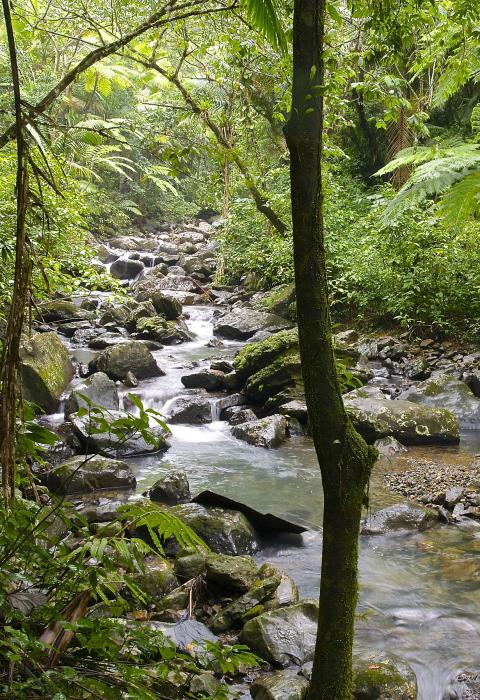Rio de la Mina
Puerto Rico
The Rio de la Mina originates in the upper elevations of the El Yunque National Forest at over 2,000 feet elevation in a cloud forest and flows from there in a northernly direction. The river is bounded by steep, rugged slopes throughout its length with large boulders along the shore and within the stream which forms many rapids, waterfalls, and frequent pools. The lush and varied vegetation found along the banks provide a very picturesque setting.
The Rio de la Mina is part of the Mameyes watershed, with the Rio de la Mina sub-watershed covering an area equaling 6.1% of the El Yunque National Forest. The river provides habitat for shrimp, and Puerto Rican parrots can be glimpsed at times feeding on palm fruit along the river.
Designated Reach
December 19, 2002. From its headwaters to its confluence with the Rio Mameyes.
Outstandingly Remarkable Values
Botany
The tropical moist forests of Puerto Rico are characterized for their great diversity of plants, although somewhat less so than in continental tropical forests. More tree species occur on the El Yunque than in all the other 155 national forests combined, and none of these species occur on any other national forest. Nearly one-third of the forest’s tree species are endemic to Puerto Rico, and 10% are endemic to the forest itself.
The Rio de la Mina corridor within the forest contains five ecological life zones—subtropical wet forest, subtropical rain forest, lower montane wet forest, lower montane rain forest, and a small area of subtropical moist forest. Its vegetation includes four major forest types—Tabonuco, Palo Colorado, Sierra Palm, and Cloud Forest.
The core of the forest remains in primary condition without significant human modification. This primary forest is the largest remnant of the original forest that covered virtually the entire island at the time of Columbus’ arrival more than 500 years ago. The primary forest presents a unique window to the past and a natural control against which past, and ongoing changes, in Puerto Rico’s and other tropical forests, can be measured. It provides the only currently suitable habitat for many endemic plant species.
Geology
Elevation on the Forest ranges from 100 feet at the northern boundary, to 3,533 feet at El Toro Peak. Terrain ranges from gentle slopes in low elevations to rugged side slopes exceeding 60% in higher elevations, where vertical rock-faced cliffs are numerous. On the forest’s north slopes, the Rio de la Mina drops rapidly at high elevations and more gradually below. Geologic parent materials are of three basic types—marine-deposited Cretaceous volcanic rocks, the most widespread; tertiary intrusive quartz diorites on the south side of the forest; and quaternary unconsolidated alluvial deposits (sand, gravels, silts, and clays) along major water courses.
History
The forest contains a variety of historical and cultural resources spanning pre-Columbian, Spanish colonial, and the early twentieth century. The Rio de la Mina probably derives its name from a mid-1800s Spanish Colonial period mining complex located within the scenic section or from a possibly earlier mining complex further upstream within the recreation section.
Recreation
The major recreational experiences are passive enjoyment of the natural environment, picnicking, wading in the water, and hiking. Currents within the rivers are generally conducive to water play. The river is relatively shallow and has easy access between the rocks and along the banks. The large boulders make the stream a good place for sitting and cooling off. Recreation tends to be family activity oriented. Most of the river corridor is primitive with minimal human activity. Bird watching and nature photography are also very popular along the river corridor.
Scenery
The river has a moderate to steep gradient and rapid/pool flow characteristics with many cascades and small waterfalls. The swales are steep and wide with extensive exposed bedrock. The streambed is rocky with numerous large boulders. La Mina Falls, one of the most attractive waterfalls found in the forest, is located In the Rio de la Mina recreation segment. The falls is found at the meeting point of two of the most used trails, the La Mina Trail and the Big Tree Trail.
Wildlife
The fauna that is found along the river corridor is one of the most distinguishable communities in Puerto Rico. Species exhibit traits unique only to tropical ecosystems. Aquatic, bird, and terrestrial animal species on the forest have many distinct characteristics that have evolved through interactions that promote specialization. The range of species includes over 127 terrestrial vertebrates, 77 bird species, and 17 freshwater fish species. The El Yunque boasts a spectacular degree of biodiversity in comparison to other national forests. Wildlife can be observed and photographed in the treetops, along the shoreline, and in the water of the Rio de la Mina.

